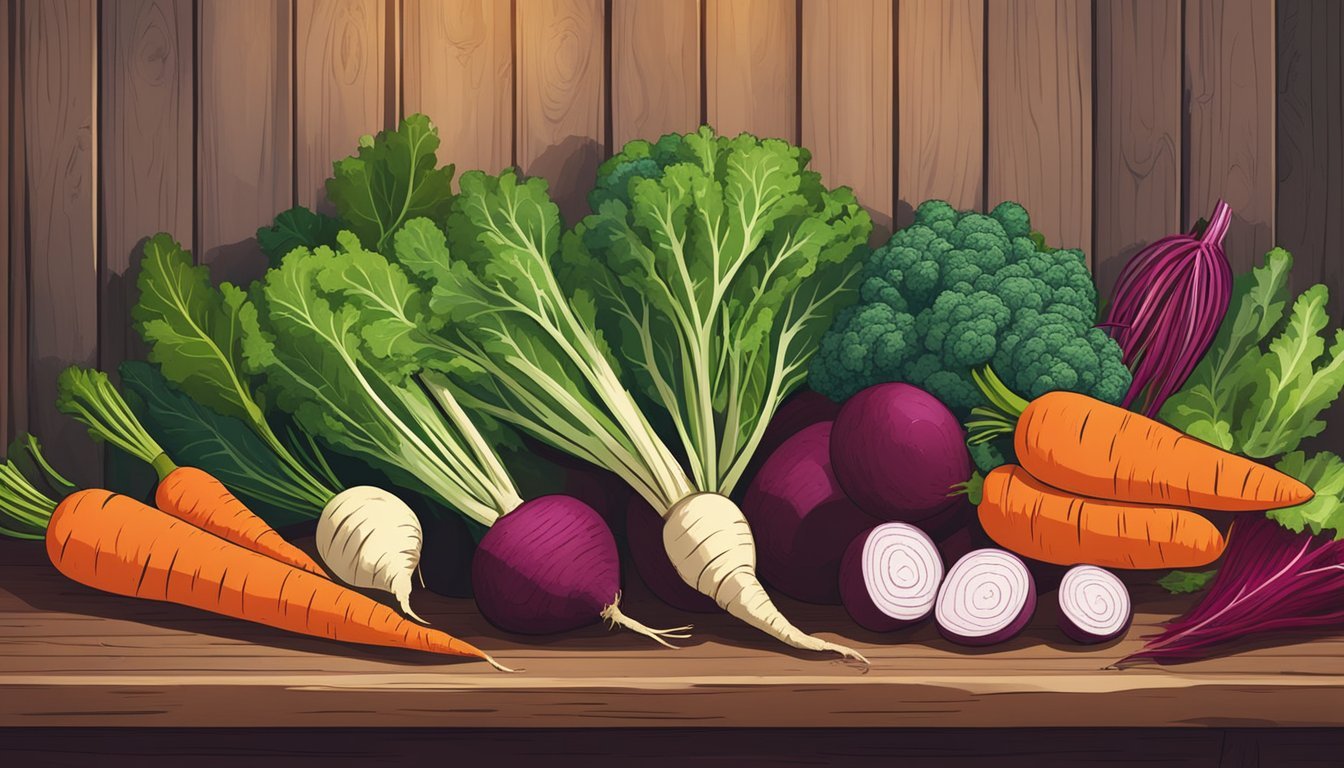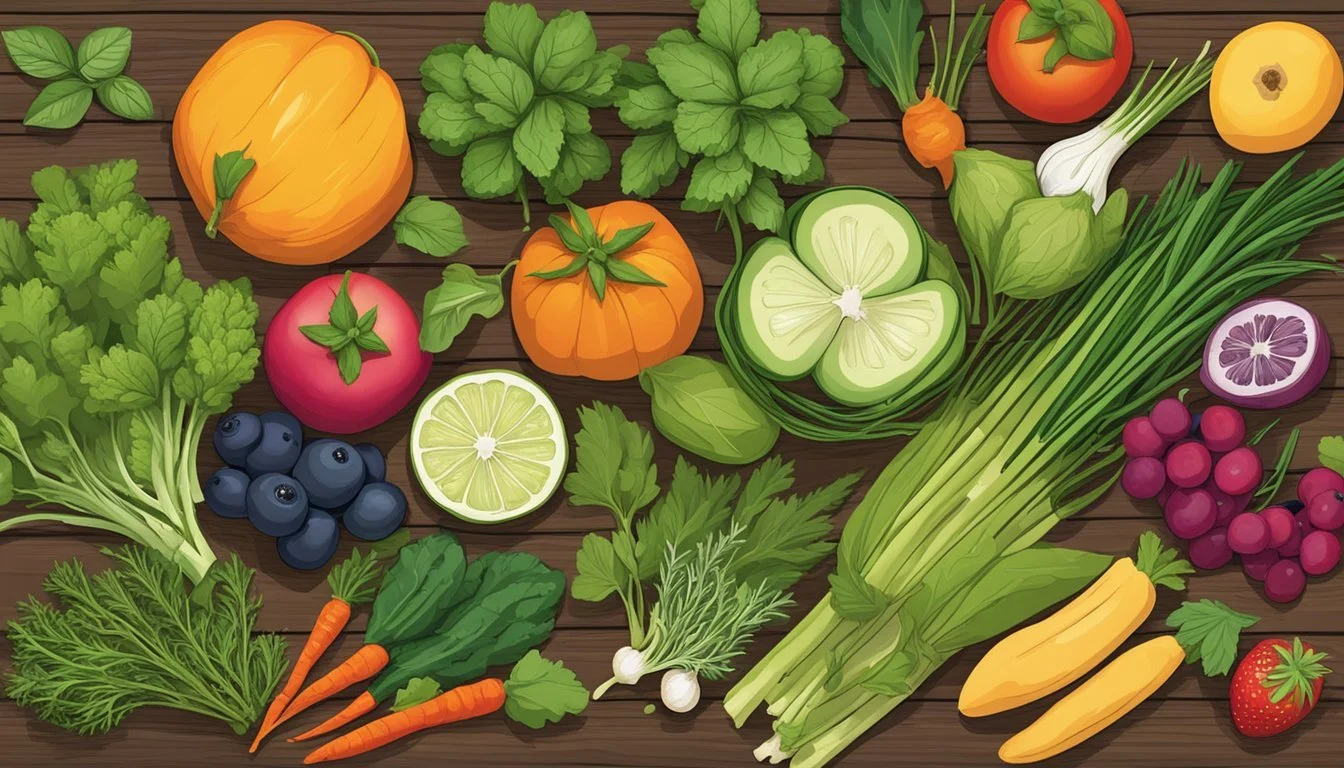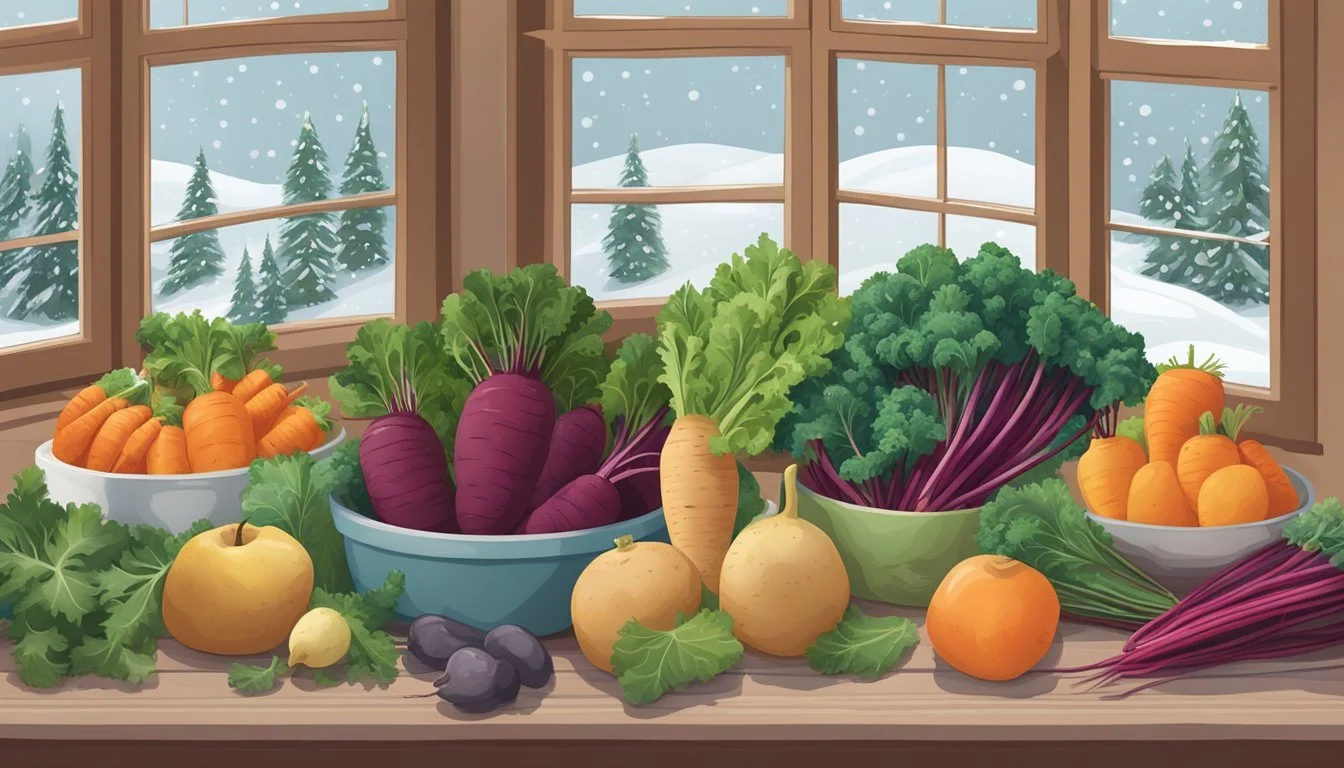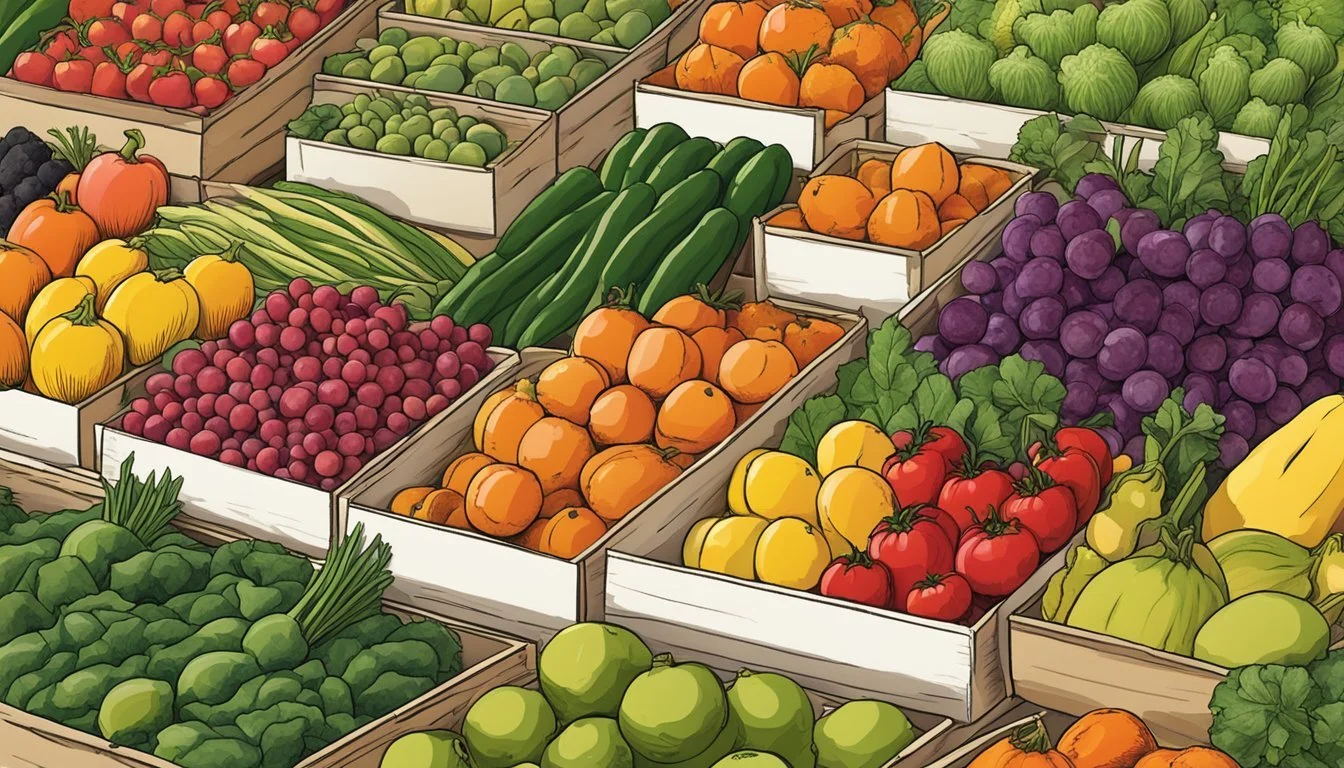Utah Seasonal Fruit & Vegetables in February
Your Guide to Fresh Produce
This Article is Part of our Utah Seasonal Fruit & Veg Calendar
February in Utah presents unique opportunities for sourcing seasonal produce despite the cooler temperatures. During this time, the selection of fresh fruits and vegetables might be more limited due to the winter conditions, but there are still numerous options available for those interested in consuming local and seasonal items. Citrus fruits, such as lemons, limes, and oranges, often reach the peak of their quality in these colder months. Shoppers can also find a variety of root vegetables and hardy greens that are well-suited to the winter climate.
Local farmers and producers adapt to the season by harvesting crops that are able to thrive in the colder weather or by utilizing controlled environments like greenhouses. This means that while traditional farming may slow down, produce such as arugula and other hothouse-grown greens can still be found fresh in the market. Utah's cold storage facilities also ensure that certain crops harvested in the previous seasons, such as apples, remain available to consumers.
Consumers looking to make the most out of the local seasonal produce in this month may lean towards root vegetables like beets (how long do beets last?), which are not only harvested during this time but also store well and can add a robust flavor to winter dishes. As residents of Utah navigate the produce offerings in February, they can take comfort in knowing that even during the winter, options for fresh, seasonal eating do exist.
Overview of Utah's Seasonal Crops
In February, Utah's seasonal produce is limited due to the winter season. However, some hardy crops are still available, and the importance of seasonal eating remains a key consideration for consumers and farmers alike.
Characteristics of Winter Produce
During the winter months, produce that can withstand the cold dominates the offerings at Utah’s farmers markets. Hardy root vegetables like carrots (how long do carrots last?) and storage crops such as apples that have been harvested in fall are commonly available. These items are often celebrated for their ability to retain freshness throughout the winter. Indoor growing and greenhouse cultivation also contribute to the availability of certain crops outside their conventional outdoor growing season.
Importance of Seasonal Eating
Seasonal eating in Utah during February ensures that consumers receive maximum nutrition and flavor from their produce. It supports local agriculture by aligning consumer habits with the harvest cycles, thereby encouraging sustainability. Additionally, purchasing seasonal crops can be more economical, reducing costs associated with transport and storage of out-of-season produce.
Fruits Available in February
In Utah during February, despite the cold weather, consumers can still enjoy a variety of fresh fruits, especially those that store well from the previous harvest and a selection of bright citrus fruits.
Citrus Varieties
Utah's February fruit selection prominently features citrus fruits, which are at peak season. Grocery stores and markets often carry:
Lemons: Known for their tart flavor and high vitamin C content, they add a fresh burst to a wide array of dishes.
Oranges: Sweet and juicy, oranges are versatile, consumed fresh, and also used in recipes.
Grapefruit: These large citrus fruits have a slightly bitter but refreshing taste and are packed with vitamins.
Citrus fruits remain a highlight during this time, providing fresh flavors and nutritional benefits amidst colder climates.
Storage Fruits
Several fruits that were harvested in late summer and fall are stored and remain in good condition through February, such as:
Apples: With many varieties, they retain their crisp texture and can be found in several dishes from pies to salads.
Pears: These sweet fruits soften over time but still hold up well for culinary use in both sweet and savory contexts.
Seasonal Vegetables in February
In February, Utah's winter climate still dominates, dictating a harvest that focuses on hearty vegetables capable of withstanding colder temperatures. Two main categories, root vegetables and leafy greens along with cruciferous vegetables, provide an array of nutritious options during this month.
Root Vegetables
Root vegetables are at their best in February due to their ability to store energy and sweetness when grown in colder months. They are typically denser and packed with nutrients, making them ideal for winter sustenance.
Carrots: Crunchy and sweet, carrots are versatile for stews, roasts, or as snacks.
Onions: A staple in many dishes, onions add depth with their robust flavor.
Leeks: Milder than onions, leeks are perfect in soups and potato dishes.
Celery Root (Celeriac): With a subtle taste, it's an excellent base for purees or soups.
Potatoes: A versatile vegetable, potatoes can be prepared in countless ways.
Parsnips: Similar to carrots, parsnips have a sweet, nutty flavor suitable for roasting or in soups.
Leafy Greens and Cruciferous Vegetables
Leafy greens and cruciferous vegetables can withstand the chill of early spring, offering both flavor and nutrition. They are an excellent source of vitamins and essential minerals during the colder months.
Kale: This nutrient-dense leafy green is ideal for salads, chips, or sautéed as a side.
Cabbage: With its subtle sweetness, cabbage is great in slaws or fermented as sauerkraut (how long does sauerkraut last?).
Brussels Sprouts: These mini cabbages are delicious when roasted or pan-fried until crispy.
Cauliflower: Its adaptability means it can be roasted, turned into 'rice', or used in pizza crusts.
Herbs and Other Produce
In February, the cold climate of Utah limits the availability of fresh produce, but certain herbs and vegetables persist through the winter months, providing a valuable addition to the local food scene.
Herbs such as thyme and parsley remain hearty choices for the winter garden. They are capable of enduring the cold when sheltered appropriately, such as under cover or in greenhouses. Cultivation of these herbs indoor can yield fresh flavors even when outdoor conditions are less favorable.
Garlic, while traditionally planted in the fall, is contending with the freezing temperatures beneath the soil, slowly developing its robust bulb, which will be ready for harvest later in the year.
Sprouts, including the likes of alfalfa or bean sprouts, can be grown indoors, offering a crunch and a kick of flavor to winter dishes. They require minimal space and can be a source of fresh greens even in the depths of winter.
Speaking of greens, although the farm fields lie fallow, certain hardy greens can survive the cold. Growers may protect these greens from frost by applying coverings:
Collard greens (how long do collard greens last?): Often shielded from harsh conditions and best harvested before they become too bitter.
Spinach: Also capable of withstanding cooler temperatures and can be harvested for a fresh, nutritious addition to meals.
These crops highlight the ingenuity of Utah farmers, who optimize their practices to extend the availability of local produce throughout the winter season.
Preparing Winter Produce
With a variety of winter produce available in Utah in February, one can enhance their culinary experiences by focusing on the most suitable cooking methods for these seasonal offerings. The following subsections will elaborate on the optimal ways to prepare winter fruits and vegetables and provide specific recipe ideas to make the most out of these seasonal harvests.
Cooking Methods
Roasting: Root vegetables such as carrots, beets, and potatoes, as well as winter squash, can be beautifully caramelized through roasting. To roast, one should preheat the oven to 400°F (200°C), toss the chopped vegetables with olive oil, salt, and pepper, and spread them on a baking sheet for approximately 25-30 minutes or until tender and golden brown.
Recipe Ideas
Salads: Utilize fresh kale or mixed greens as the base for a vibrant salad. Add slivers of roasted beets, slices of salt-roasted carrots, and top with a homemade vinaigrette dressing. For a sweet twist, incorporate segments of blood oranges or grapefruit.
Salsa: A winter salsa can be made from diced avocados, blood oranges, and roasted sweet potatoes, seasoned with lime juice and cilantro. This multi-textured salsa pairs well with grilled fish or as a hearty dip with tortilla chips (how long do tortilla chips last?).
Acquiring Seasonal Produce
February presents a limited yet distinctive range of produce in Utah, thanks to its climate and growing season trends. Local farmers markets and home gardens offer a route to these seasonal offerings.
Local Farmers Markets
Farmers markets operate as a primary hub for fresh, seasonal produce, even in the colder months. Patrons looking to acquire produce harvested in February should inquire about market schedules and locations, as many markets adjust their days of operation during the winter. Produce typically available includes hearty winter vegetables and storage crops such as squash, onions, and root vegetables.
Winter Greens: Kale, Spinach
Root Vegetables: Beets, Carrots, Potatoes
Squash Varieties: Acorn, Butternut
The offering at farmers markets can be indicative of a successful winter harvest, showcasing the productivity of Utah's growing season.
Home Gardening Tips
For individuals with a green thumb, starting seeds indoors during February is a practical step in anticipation of the spring planting season. Hardy plants like kale and spinach can be started under grow lights or on a sunny windowsill to prepare for an early spring transfer to the garden. Utah's dry climate demands thoughtful water management, and in the latter part of February, preparing soil with adequate organic matter can help retain moisture for the upcoming growing season. When harvested promptly and cared for, a home garden can yield impressive results and contribute to self-sufficiency.
Benefits of Seasonal Consumption
Consumers gain multiple advantages when they choose to eat fruits and vegetables that are in season, ranging from enhanced nutrition to benefits for both the economy and the environment.
Nutritional Advantages
Seasonal produce in Utah offers significant nutritional benefits as fruits and vegetables harvested at their peak ripeness are richer in vitamins and minerals. For example, tomatoes vine-ripened contain up to 50% more vitamin C than those ripened off the vine. Similarly, potatoes can lose half of their vitamin C content after 90 days of storage. By consuming produce that is fresher and ripened naturally, individuals can enjoy a diet that is more nutrient-dense, which may help in reducing the risk of certain health conditions and promote overall health.
Economic and Environmental Benefits
Choosing to buy seasonal produce aids not only the local economy but also has a favorable impact on the environment. Purchasing from local farmers supports the local economy and can reduce the carbon footprint associated with long-distance transportation of produce. It often results in a lower price for consumers due to decreased transportation costs and the abundance of the produce. Furthermore, seasonal farming practices tend to be more sustainable and can contribute to soil conservation and reduced water usage, which bolsters the environmental health of the farming regions.








